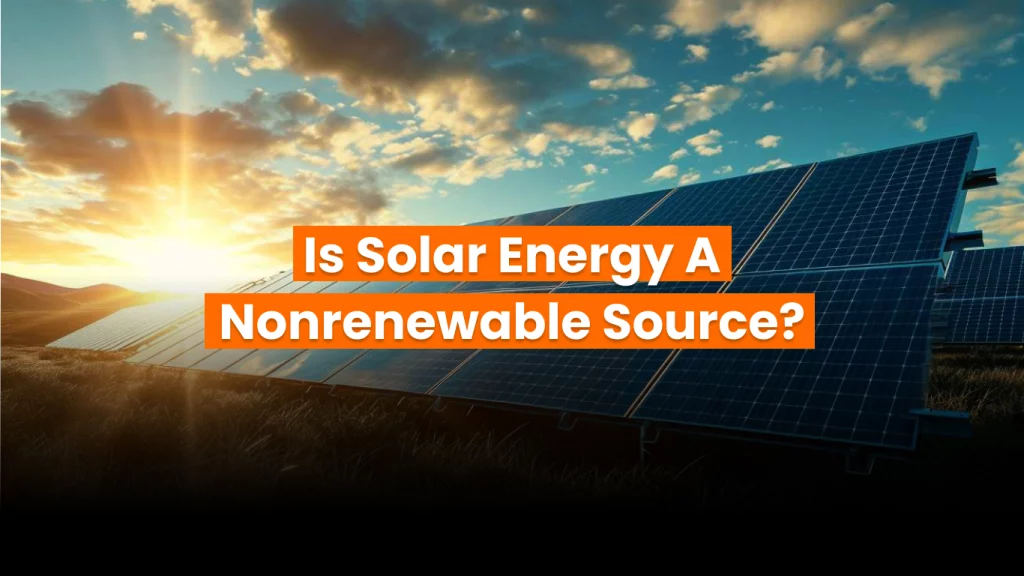In plain terms: solar energy is renewable, not nonrenewable.
That means it comes from a source that naturally replenishes on human timescales,unlike coal, oil, or natural gas, which take millions of years to form and can be depleted. Solar energy flows to Earth as sunlight, which is abundant and virtually limitless over our lifetimes,and even over generations.
Renewable vs. nonrenewable: What’s the difference?
- Renewable energy comes from sources that can be naturally replenished,solar, wind, hydro, geothermal.
- Nonrenewable energy includes fossil fuels like coal, oil, and natural gas, which are finite and formed over geological timescales. Once used up, they cannot be replenished during human lifetimes.
Solar energy is driven by nuclear fusion reactions inside the sun. Scientists estimate the sun is about halfway through its 10-billion-year lifespan,meaning we still have around 4.5 billion years of solar energy ahead. From our perspective, sunlight is effectively an endless resource.
How solar energy is captured and used
Solar energy is harnessed in two main ways:
- Photovoltaic (PV) technology, where solar panels convert sunlight directly into electricity using the photovoltaic effect.
- Concentrated solar power (CSP), which uses mirrors or lenses to focus sunlight to create heat, driving turbines to generate electricity.
PV panels are now widespread on rooftops and in massive solar farms. In 2024, solar power generated 6.9% of global electricity, and accounted for nearly two-thirds of new electricity capacity additions,making it the fastest-growing source of clean energy on Earth. In the U.S., solar generation jumped to over 303 TWh in 2024, with total installed capacity reaching about 239 GW across both utility-scale and small-scale system.
Environmental impact: Green credentials of solar
Solar energy earns the label “green” or “clean” because it generates electricity without burning fossil fuels,so there are no on-site greenhouse gas emissions or air pollution during operation.
Manufacturing solar panels has some environmental footprint, materials extraction, energy use, etc., but studies show that a solar panel typically generates more clean energy in just a few months than it took to produce. And as manufacturing advances, that environmental “payback” timeline continues to shrink. Many panels are recyclable too, helping reduce end-of-life waste.
How efficient is solar energy?
Levelized cost of electricity (LCOE) measures lifetime cost versus electricity output. Recent analyses show that utility-scale solar PV yields one of the lowest LCOEs among all new generation technologies,often cheaper than coal or natural gas on a per‑kilowatt-hour basis. Reddit-based energy analysis confirms that wind and solar deliver higher net energy return than fossil fuels,even considering intermittency and storage needs.
In 2023, utility-scale solar power generations in the U.S. topped nuclear output for the first time, reflecting rapid growth and improved economics in the sector.
Limitations of solar energy
No energy source is perfect. Solar energy has a few notable limitations:
- Intermittency: Solar generation stops at night and drops on cloudy days. Without storage, energy supply can’t be guaranteed constantly.
- Upfront costs: Installing panels, inverters, wiring, and associated labor is capital-intensive, though costs continue to fall.
- Storage needed for reliability: To provide round-the-clock power, solar often requires paired battery systems or hybrid setups.
- Grid integration challenges: Managing large-scale PV without storage can strain power grids, requiring smarter infrastructure and diversified energy portfolios.
Solar’s role in a cleaner energy future
Thanks to falling costs, policy support, and technological innovation, solar is rapidly increasing its share of global electricity supply. Renewable energy as a whole surpassed 30% of global electricity generation in 2023, with solar leading the charge.
In the U.S., renewable sources including solar and wind are overtaking traditional nuclear and fossil fuel plants. By mid‑2024, solar generation reached record levels and solar capacity continues to climb,installations up 168% from 2018 to 2023.
In many states, renewable portfolio standards (RPS) require utilities to derive a growing portion of their electricity from clean sources. More than 30 states now mandate utility companies meet specific renewable energy quotas, helping propel solar growth via market-backed certificate programs.
Why solar is here to stay
- Unlimited fuel: As long as the sun shines, solar energy is available,effectively infinite for human needs.
- Declining costs and growing efficiency: Technology improvements and economies of scale continue reducing installation costs and boosting panel output.
- Positive environmental impact: Lower carbon emissions, minimal pollution, and potential recycling pathways make solar a sustainable choice.
- Policy and economic momentum: Incentives such as RPS mandates, tax credits, and rapid utility-scale deployment support solar’s continued expansion.
Solar is renewable, reliable, and relevant
It’s clear: solar energy is not a nonrenewable source, it’s a renewable resource that offers clean, sustainable power. While it has some limitations (like intermittency and upfront cost), the benefits far outweigh them.
For anyone questioning whether solar energy belongs in a clean, sustainable future,the answer is unequivocal: solar is renewable, abundant, and essential for the energy transition.




